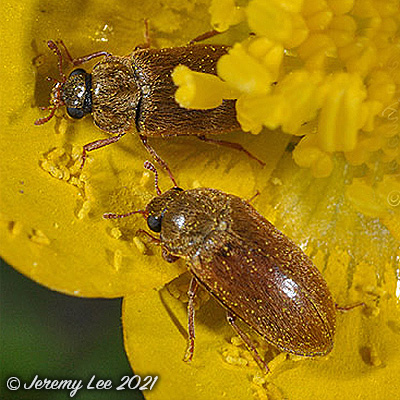
 |
|
Scientific Classifications explained » Amphibians » Ants » Aphids » Bees » Beetles » Birds » Bugs » Butterflies » Caterpillars » Damselflies » Dragonflies » Earwigs » Flies » Frog/Leafhoppers » Fungi » Galls » Grasshoppers » Harvestmen » Hoverflies » Lacewings » Ladybirds » Leaf Mines » Lichens » Mammals » Millipedes » Mosses » Moths » Sawflies » Slugs » Snails » Spiders » Trees & Shrubs » Wasps » Wild Flowers » Woodlice » Postboxes |
UK Nature > Beetles > Byturus ochraceus

Scientific Name: Byturus ochraceus Common Name: Pollen Beetle Byturus ochraceus and Byturus tomentosus are the only two representatives of their family in Western Europe. The two species are very hard to tell apart, the difference being in the eyes and genitals. Usually, however, B. ochraceus is slightly bigger, darker and concentrates on plants of the Buttercup family, while the true Raspberry Beetle, B. tomentosus, prefers Raspberries and other plants in the family of Roses. I believe it is Byturus ochraceus illustrated above because of the darkish head, and they were photographed in a Buttercup. But adult Raspberry Beetles may visit Buttercups as well, so there is no certainty. Both species are very small, brownish beetles. Byturus ochraceus measures 4 to 5 mm, the Raspberry Beetle usually 3 to 4 mm. Adult beetles are best seen from April to June feeding on pollen in flowers, often in groups. Both species are very common. |
|

https://www.uknature.co.uk is a website dedicated to showing the immense diversity of UK nature and wildlife. Our vast range of habitats, from lowland arable to snow covered mountains, from storm-ravaged coastlines to peaceful inland freshwater lakes and rivers, from dry, sandy heaths to deciduous and coniferous forests, all these habitats contribute to the abundance of UK nature. We have wild birds in huge numbers either residing or visiting our shores (597 recorded species as at July 2013) and we must also not forget the humble back garden with its grass lawns, flower beds filled with nectar rich flowers, shrubs and trees, all designed to attract huge numbers of insects such as bees, moths, butterflies and hoverflies; and finally the small ponds which provide safe havens for frogs, toads, newts and even slow worms and grass snakes. www.uknature.co.uk is the showcase for my personal passion, photographing uknature in all its glory. I sincerely hope you all enjoy the fruits of my labours. This site and all images contained therein is © Jeremy Lee 2004 - 2025. All Rights Reserved. Site design by Jeremy Lee. Site development & IT Support by Stuart Lee. |